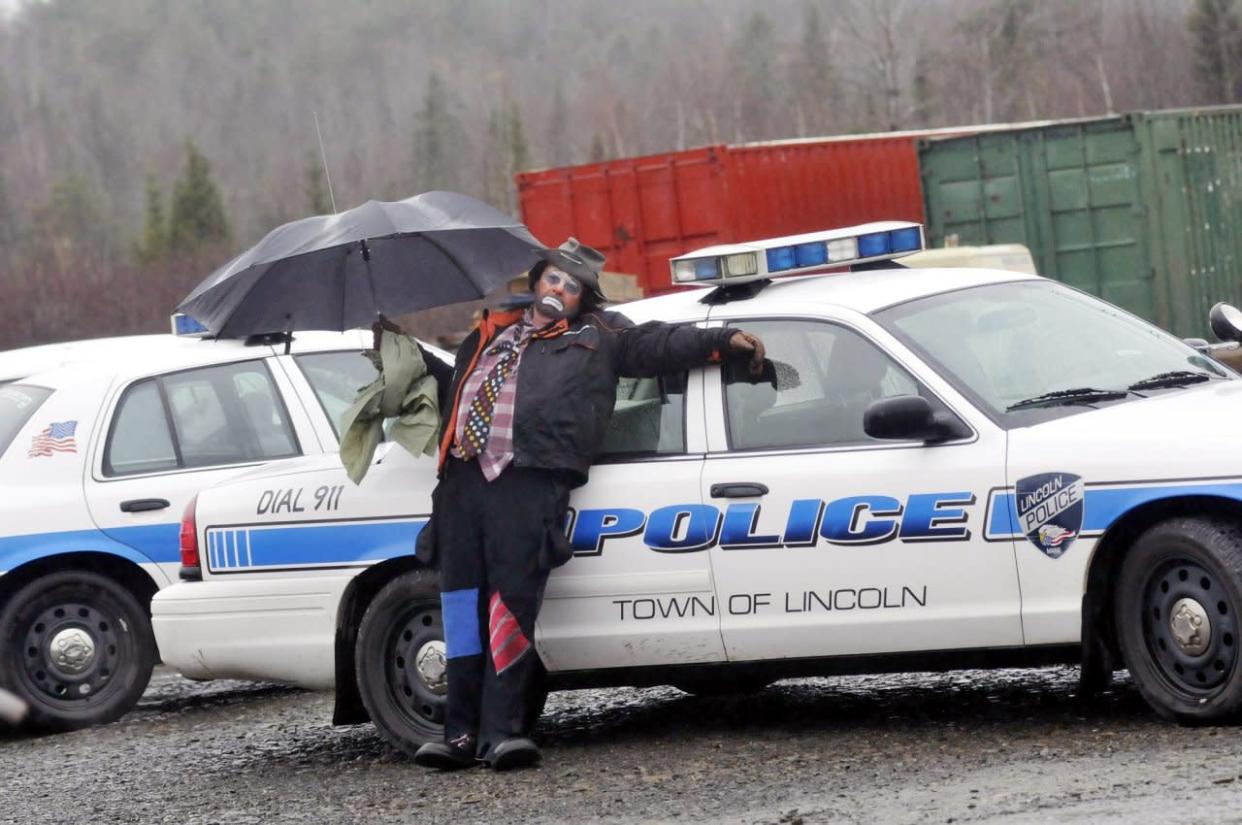 Daily Brew
Daily Brew'Call the police' if creepy clowns cause concern

[A non-creepy clown with a cause, Don Thomas draped on a police car at a 2010 protest of the Rollins wind energy project in Lincoln, Maine. Shawn Patrick Ouellette/Getty Images]
Police are advising people put safety first if faced with a “creepy clown” in their neck of the woods.
Around Waterloo, police increased patrols after about a dozen so-called creepy clown sightings in the Southern Ontario region.
One call over the weekend involved three people in clown costumes, one allegedly holding a large stick, chasing a woman near the University of Waterloo campus.
It’s one of the latest in a string of creepy clown reports from all over Canada.
Just last Friday, two people dressed in clown costumes chased kids at a west-end Toronto school. Police say they detained two 15-year-old suspects who were doing it as a prank.
“I don’t know where it’s coming from and if I did, I’d be a higher rank than I am,” Const. Craig Brister of the Toronto Police Service told Yahoo Canada News.
“It’s a weird phenomenon and somehow, it’s captured people’s attention. And we’re hoping that it passes.”
Indeed, the clown thing has spiralled since the late summer, when sightings began in the U.S. It’s become so widespread that the website Atlas Obscura has created an interactive map of incidents. Meanwhile, Slate magazine says the creepy clown phenomena has been happening every few years since 1981.
The clowning phenomenon has jumped over the ocean to the U.K. as well. BBC News has reported that as of Monday, police in Wales dealt with 50 “creepy clown” sightings.
“It could be that Halloween is around the corner,” Brister suggested. “Who knows?”
For many, even seemingly harmless clowns are not simply a nuisance — they are full-fledged frights. “Coulrophobia” describes an irrational fear of clowns that causes nausea, sweating, and sometimes anger for being placed in the path of a clown. Polling firm Rasmussen said in a 2014 survey that 43 per cent of Americans “don’t like” clowns and more than six per cent are “terrified” of them.
Of course the fear of bad clowns isn’t always irrational. Serial killer John Wayne Gacy was known as the “Killer Clown” for his penchant to dress up with some of his victims.
Clowns have also served to scare in pop culture, including the villainous Joker from the Batman franchise and the work of horror novelist Stephen King.
A new film version of King’s 1986 book IT, featuring Pennywise the clown, is currently in the works. Much of the filming took place in Toronto, Port Hope and Oshawa, Ont. over the spring and summer, leading some to surmise that news of the remake has triggered a kind of clown salute to King’s book ahead of the September 2017 release.
This supposed fan tribute hasn’t thrilled King. The writer urged people in a tweet to cool it on clowning.
What to do if you see some strange clowns?
“It’s really just common sense. Do what you would do in any situation [that’s an emergency] - call the police,” Brister said.
“If you see something that just isn’t right, and you can feel that — you call us first.”
Brister says the police wouldn’t want members of the public to be chasing down or confronting anyone.
“Look, people get hurt when that happens.”
He doesn’t want them taking photos or video unless they know they are at a safe distance from any creepy clowns or individuals that may harm them.
“We live in an age where the instinct is to take a shot or video and to post it. Everyone wants to get that weird photo or video up but [taking it] could also trigger a reaction and we don’t want that.”
Brister admits photos and video are very useful in an investigation but reiterates that the first response — if you feel something is wrong — is to call the police.
“I’ve been a policeman for 17 years and I don’t recall anything like this clown thing happening,” he said.
There is one clown Brister wouldn’t mind seeing up close, though.
“Oh yes, I plan to see [It],” Brister said. “It’s a great book! I read a lot of Stephen King when I was a kid.”



